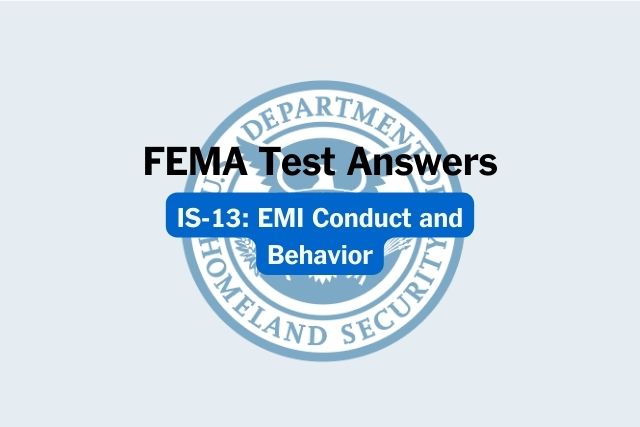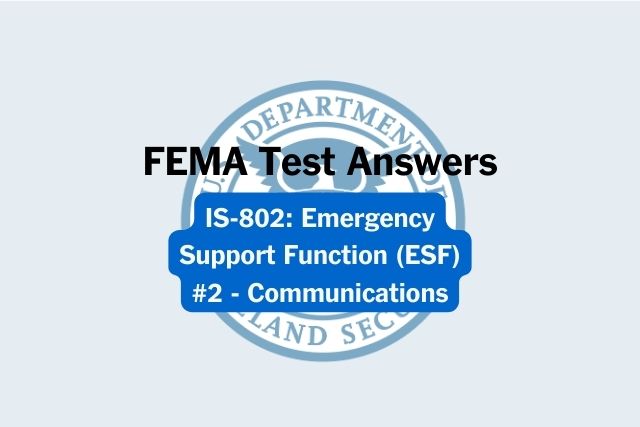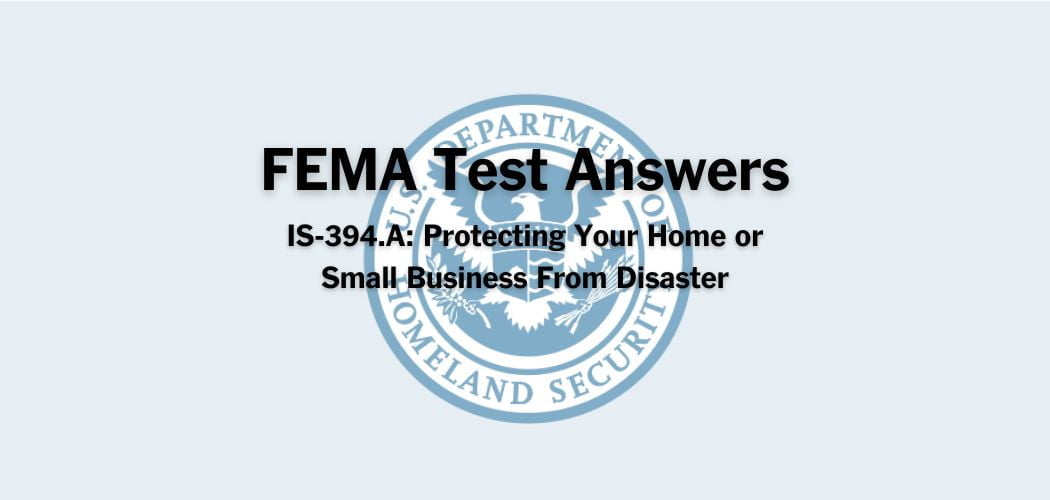Overview: The FEMA IS-285 course was published on 3/17/2020 to help assist tribal, local, and State officials in making substantial damage determinations in accordance with the NFIP using the FEMA Substantial Damage Estimator (SDE) software.
FEMA IS-285 test answers
Each time this test is loaded, you will receive a unique set of questions and answers. The test questions are scrambled to protect the integrity of the exam.
Question 1. The accuracy of the community data used to compile the assessment list can impact the inventory of properties assessed. What can the Substantial Damage Estimator (SDE) tool NOT do?
A. View recent assessments
B. Determine damages
C. Select depreciation ratings
D. Identify omitted properties✅
Question 2. Assessment teams should have Right of Entry granted by local authorities. What does this permit when the owner is not present?
A. Access to the exterior of all properties and interiors of all residential properties✅
B. Access to the exterior of all properties and interiors of all non-residential properties
C. Access to the exterior of properties
D. Full access to all properties
Question 3. When using the Substantial Damage Estimator (SDE) tool, what data must first be assembled?
A. Data about the local flood damage prevention ordinances
B. Data on the structures in the mapped Special Flood Hazard Areas (SFHAs) , e.g. longitude and latitude coordinates
C. Data on all the Special Flood Hazard Areas (SFHAs) within the community’s boundaries
D. Data profiles for each substantial damage assessor✅
Question 4. What should you do if the final percent damaged is estimated between 40% and 60%?
A. Negotiate the estimated percent damaged with the structure owner
B. Double-check your values and discuss them with your partner
C. Double-check your values and discuss them with the structure owner✅
D. Double-check your values
Question 5. Which is an accurate statement regarding the substantial damage assessment process?
A. The exact dimensions of the structure are not necessary.✅
B. Multiple assessments are needed to obtain all the required damage data.
C. Assessment teams can access private properties that have a locked gate or similar obstruction to the entire property.
D. Depreciation should not be considered when estimating percent damage to structural elements.
Question 6. Which best practice can help facilitate the substantial damage determination process and avoid inaccurate information?
A. Spending 1 hour or more assessing the elements of a structure
B. Taking photographs while in the field✅
C. Interviewing building owners to get their damage assessment
D. Importing data from other databases
Question 7. What is the formula for the base cost, or starting point, for determining the value of the structure?
A. Building value divided by repair cost equals base cost.
B. Repair cost divided by building value equals base cost.✅
C. Square footage multiplied by unit cost equals base cost.
D. Square footage equals unit cost multiplied by base cost.
Question 8. Which structural element is assessed separately in residential structures but not in non-residential assessments?
A. Electrical
B. Cabinets and countertops✅
C. Superstructure
D. Foundation
Question 9. When completing a non-residential assessment, if the best structure type is only available if you select an inaccurate number of stories, which rule should you follow?
A. Choosing the correct number of stories should take precedence over choosing the most appropriate structure use.
B. Choosing the most appropriate structure use should take precedence over choosing the correct number of stories.✅
C. Communities must develop their own procedures to deal with discrepancies in structural characteristics and Substantial Damage Estimator (SDE) tool data entry options.
D. It is the assessor’s preference, as long as the notes make clear which value is inaccurate.
Question 10. Which residential structural attribute includes: Shingles, standing seam (metal), slate, and clay tile?
A. Roof Covering✅
B. Superstructure
C. Exterior finish
D. Foundation
Question 11. When assessing damages, to what percentage value should you round your estimations?
A. 25%
B. 20%✅
C. 10%
D. 5%
Question 12. What is critical for determining the pre-damage market value of a structure and establishing credibility with building owners?
A. Adjustment costs✅
B. Repair costs
C. Base cost
D. Unit cost data
Question 13. How does the Substantial Damage Estimator (SDE) assist communities that participate in the NFIP?
A. It can support the enforcement of required local flood damage prevention ordinances.✅
B. It is a repository for answers to frequently asked questions (FAQs) for substantial damage assessments.
C. It provides detailed instructions on how to use the Substantial Damage Estimator (SDE) tool.
D. It is a repository for best practices for substantial damage determinations.
Question 14. Substantial damage assessors need to begin fieldwork as soon as possible after the damage event. In most cases, when should field work begin?
A. Within 1 week of the event✅
B. Within 2 weeks of the event
C. Within 10 days of the event
D. Within 1 month of the event
Question 15. Which residential structural attribute includes: Stud-framed, masonry, insulated concrete forms (ICF), and common brick?
A. Roof Covering
B. Superstructure✅
C. Exterior finish
D. Foundation
Question 16. When using the Substantial Damage Estimator (SDE) tool for a residential assessment, which Address tab fields are required?
A. National Flood Insurance Program (NFIP) Community ID and NFIP Community Name
B. Parcel Number and National Flood Insurance Program (NFIP) Community Name✅
C. Subdivision and National Flood Insurance Program (NFIP) Community Name
D. Parcel Number and Lot Number
Question 17. The Substantial Damage Estimator (SDE) tool’s Main Menu is subdivided into three groups: Reports and Data Features, Resources, and what other group?
A. Access Data✅
B. Bulk Editor
C. Generate GeoFile
D. Residential Assessments
Question 18. What can Substantial Damage Estimator (SDE) tool data help communities to demonstrate?
A. That non-residential structures designated as uninhabitable are always substantially damaged
B. When historic buildings are substantially damaged and should be torn down and replaced
C. That residential structures designated as uninhabitable are always substantially damaged
D. The community is complying with NFIP regulations.✅
Question 19. Which is the best practice for substantial damage assessors?
A. Their assessments should be considered final with no opportunity for property owner appeal.
B. They should communicate and coordinate frequently.✅
C. They should work in teams of 3 or 4 when performing substantial damage assessments.
D. They should work independently in their assigned portion of the Special Flood Hazard Area (SFHA).
Question 20. A split-entry, single-family home has a second-story utility room only over the garage. Which option would you select in the Substantial Damage Evaluation (SDE) tool?
A. Two or More Stories (Standard)
B. Two or More Stories✅
C. One Story (Special)
D. One Story (Standard)
Question 21. Which residential structural attribute has the following six types: Continuous wall with slab, crawlspace, piles, piers and posts, slab-on-grade, and basement?
A. Plumbing
B. Exterior finish
C. Foundation✅
D. Superstructure
Question 22. Which Substantial Damage Estimator (SDE) tool feature allows users to edit all data fields for as many assessments as needed from a single view.
A. Resources
B. Bulk Editor✅
C. Generate GeoFile
D. Residential Assessments
Question 23. How will using unrealistic pre-damage market values impact a substantial damage determination program?
A. It will undermine the credibility of the substantial damage determinations.✅
B. It will increase the estimated overall percentage damaged to above the National Flood Insurance Program (NFIP) 50% threshold.
C. It will allow for damages from non-event sources to be included in the substantial damage determination
D. It saves time in both the short- and long-term assessment process.
Question 24. The general guidance for performing substantial damage assessments recommends issuing a public announcement before the start of fieldwork. What should that public announcement include?
A. The areas to be assessed and assessor identification procedures
B. An explanation of the purpose of the substantial damage assessments✅
C. The source for unit cost data which will be used to estimate building values
D. The identities of data collection and data entry staff
Question 25. What is the non-residential structural attribute Conveyance System referencing?
A. Ventilation system
B. Garbage ducts
C. Parking structure
D. Elevator or escalator✅
Question 26. In the Non-Residential option, what are the critical factors that the Substantial Damage Estimator (SDE) tool needs to estimate the damage to structural elements?
A. Structure Use and Construction Quality
B. Cost Adjustments and Number of Stories
C. Number of Stories and Structure Use
D. Cost Adjustments and Construction Quality✅
Question 27. Why is the Substantial Damage Estimator (SDE) tool considered a resource for seasoned substantial damage assessors?
A. It identifies all the structures designated by State or federal entities as historic structures.
B. It provides single-source access to all National Flood Insurance Program (NFIP) rules and regulations.
C. It provides an organized platform to enter data and calculate damages in a consistent format.✅
D. It provides a repository for best practices for substantial damage determinations.
Question 28. The general guidance for performing substantial damage assessments recommends that assessors should carry identification and letters of introduction from local officials. What is the benefit of providing official identification to homeowners?
A. It distinguishes substantial damage assessors from data collection staff and data entry staff.
B. It ensures cooperation from community officials and local .law enforcement
C. It supports the substantial damage assessment program’s professional image and facilitates property owners’ cooperation.✅
D. It saves time in both the short- and long-term assessment process.
Question 29. What is the minimum number of photos that should be attached to a structure’s file in the Substantial Damage Estimator (SDE) tool?
A. 4
B. 3
C. 2✅
D. 1
Question 30. Unit cost data should be as accurate as possible. What should the estimate of the square footage of the structure include?
A. All areas, habitable and uninhabitable✅
B. Only habitable areas
C. Adjusted tax assessed value
D. Professional appraisals
Question 31. The Substantial Damage Estimator (SDE) tool’s Main Menu is subdivided into three groups: Reports and Data Features, Access Data, and what other group?
A. Resources✅
B. Bulk Editor
C. Generate GeoFile
D. Residential Assessments
Question 32. How are interior elements assessed in a non-residential structure?
A. Non-residential assessments group all the structure’s interior elements together.
B. A percentage of the structure’s interior elements are representative of the damage to the entire structure.
C. The interior elements are grouped according to structure use.✅
D. Residential interior assessments and non-residential interior assessments follow the same guidelines.
Question 33. Which Substantial Damage Estimator (SDE) tool feature allows users to create a new residential or non-residential property assessment file?
A. View/Search All Records
B. Import/Export
C. Add Residential Assessment✅
D. Add Property
Question 34. What information should be written on a whiteboard and included in photographs of a structure?
A. The structure address, the current date, and the name of the assessment team or assessor’s name
B. The structure address, the current date, event/incident data, and the name of the assessment team or assessor’s name✅
C. The property owner’s name, structure address, and the current date
D. The property owner’s name, structure address, the current date, and the name of the assessment team or assessor’s name
Question 35. Which of the following would you do first when conducting a substantial damage assessment in the field?
A. Discuss the estimated percent damaged with the structure owner
B. Record damage to structural elements
C. Obtain permission from the owner to enter the structure✅
D. Record the high-water mark
Question 36. Which damage estimate range would you select when you see large sections of shingles blown off or some minor damage to the sheathing, but the structure of the roof is more or less still in place?
A. 75% to 100%
B. 50% to 75%✅
C. 25% to 50%
D. 0% to 25%
Question 37. Which best practice helps a community to create a successful and credible substantial damage determination program?
A. Using different sources for repair cost estimates and building value for individual structures in the community.
B. Spending 1 hour or more assessing the elements of a structure.
C. Selecting a single, defensible method for determining building value and requiring all substantial damage assessors to employ this same methodology✅
D. Interviewing building owners to get their damage assessments
Question 38. Which damage estimate range would you select in cases where the foundation may initially appear intact, but there are significant structural issues that make the foundation unstable?
A. 75% to 100%✅
B. 50% to 75%
C. 25% to 50%
D. 0% to 25%
Question 39. The general guidance for performing substantial damage estimates recommends taking the time to explain the purpose of the assessments to community officials and local law enforcement. What other information should be shared?
A. The identity of data entry staff
B. The schedule for the areas to be assessed✅
C. The cost per square foot, or unit cost, which will be used to estimate building values
D. The script for public announcements
Question 40. Which is a rule of thumb to use when floodwaters reach less than 18 inches above the finished first floor of a structure?
A. The electric system should be checked by a licensed electrician.
B. The final percent damaged will be less than 40%.✅
C. The final percent damaged will be between 40% and 60%.
D. The electric system should be undamaged.
Question 41. When completing a non-residential assessment which options are only active when the 2 thru 4 or 5 or more story options are selected?
A. Sprinkler System and Conveyance
B. Surface and subsurface
C. Basement✅
D. Doors and Windows
Question 42. Unit cost data should be from a credible source, like a licensed builder. What else needs to be done with the unit cost data?
A. The unit cost data must be approved by local officials.
B. The unit cost data must be validated by a second, independent credible source.
C. The unit cost data must be converted to multiple equivalent units; e.g., yards, meters, etc.
D. The unit cost data must be adjusted for local conditions.✅



